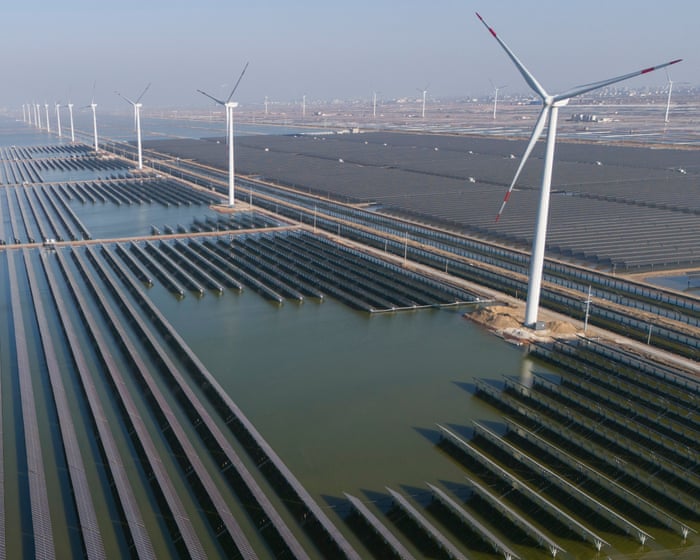Analysis shows that China’s carbon dioxide emissions have remained stable or decreased over the past 18 months, suggesting the world’s largest polluter may have reached its peak CO2 emissions target earlier than planned.
This trend is partly due to rapid growth in solar and wind power, which expanded by 46% and 11% respectively in the third quarter of this year. These renewable sources helped keep energy sector emissions flat despite rising electricity demand.
China installed 240 gigawatts of solar capacity and 61 gigawatts of wind power in the first nine months of this year, putting it on course for another renewable energy record in 2025. Last year alone, the country added 333 gigawatts of solar power—more than the rest of the world combined.
Research by the Centre for Research on Energy and Clean Air (CREA) for Carbon Brief found China’s CO2 emissions in the third quarter of 2025 were unchanged from the previous year. This was helped by reduced emissions from travel, cement, and steel industries.
These findings emerge as global leaders meet in Brazil for COP30, amid growing urgency to address the climate crisis. Neither Chinese President Xi Jinping nor US President Donald Trump attended the summit, though China sent a delegation.
UN Secretary-General António Guterres recently warned that failing to limit global warming to 1.5°C would represent “moral failure and deadly negligence.”
COP30 President André Corrêa do Lago praised China’s progress in green technology, noting that solar panels have become cheaper and more competitive than fossil fuels. He added that wealthy nations have lost their drive to confront the climate crisis.
Lauri Myllyvirta, CREA’s lead analyst, cautioned that China’s 2025 emissions might still see a slight increase depending on fourth-quarter results. However, if patterns from previous years hold—where electricity demand and emissions peak in summer—annual CO2 emissions could decline.
China aims to peak emissions by 2030 and achieve carbon neutrality by 2060. Its latest climate targets call for a 7-10% reduction in greenhouse gases from their peak by 2035. Experts consider these goals too modest to prevent global disaster, falling short of the feasible and necessary 30% cut.
Yet China has a history of exceeding its climate targets. Li Shuo of the Asia Society Policy Institute views the new goals as a baseline rather than a ceiling.
While China appears on track for early peak emissions, Myllyvirta noted some sectors are moving against the decarbonization trend. Transport sector emissions fell by 5% in the third quarter, but emissions from plastics and chemical production rose by 10%.
China is also likely to miss its 2020-2025 carbon intensity target (CO2 emissions per unit of GDP). This means steeper reductions will be needed to achieve its 2030 goal of cutting carbon intensity by 65% compared to 2005 levels.
Attention in China now turns to the 15th…The government’s five-year plan for 2026-2030 outlines its priorities and policies. Although the full text won’t be released until next year, Chinese officials have indicated that low-carbon energy systems will be a key focus. As one article notes, “There is only one player” when it comes to why China is emerging as a global leader in green energy.
Frequently Asked Questions
Of course Here is a list of FAQs about the stabilization and decrease of Chinas CO2 emissions designed to be clear concise and helpful for a general audience
BeginnerLevel Questions
1 What does it mean that Chinas CO2 emissions have stabilized or decreased
It means that the total amount of carbon dioxide gas released into the atmosphere from activities in China has stopped growing and has for the last year and a half either stayed the same or gone down slightly
2 Why is this a big deal
China is the worlds largest emitter of CO2 so any change in its emissions has a major global impact A decrease or halt in growth is a significant and positive step in the global fight against climate change
3 Whats causing this decrease
The main reasons are a major push for renewable energy a slowdown in construction and heavy industry and government policies aimed at reducing air pollution and meeting climate goals
4 Is this just a temporary thing because of the economy
Its likely a combination of factors A slower economy plays a role but the consistent longterm investment in clean energy suggests this is also part of a deliberate and ongoing shift
5 Does this mean the climate crisis is solved
No not at all While this is excellent news global CO2 levels are still very high This is a step in the right direction but much more rapid and widespread action is needed worldwide to avoid the worst impacts of climate change
Advanced Practical Questions
6 What specific policies has China implemented to achieve this
Key policies include
National ETS A capandtrade system that puts a price on carbon for the power sector
Dual Control Targets Limits on both energy consumption intensity and total energy use
Massive Renewable Investment China is the worlds leading installer of solar panels and wind turbines
7 How reliable is the data on Chinas emissions
This is a common question The data comes from a combination of sources Chinese government statistics international agencies like the International Energy Agency and independent scientific analyses that use satellite data to track pollution and power plant activity which helps verify the reports




